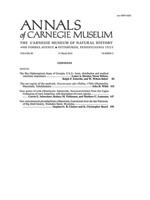A new genus of crab from the Late Cretaceous of Antarctica increases diversity within Necrocarcinidae Förster, 1968, and demonstrates what appear to be gradual evolution and sympatric speciation in the southern high latitudes. New taxa include Hadrocarcinus tectilacus, new genus, new species, as well as two new combinations, Hadrocarcinus carinatus (Feldmann et al., 1993) and Hadrocarcinus wrighti (Feldmann et al., 1993). Necrocarcinidae was paleogeographically widespread by the middle Early Cretaceous, but the geographic distribution and diversity of the group increased even further by the middle Late Cretaceous, perhaps as a result of high sea levels and elevated global temperatures at that time. The paleogeographic range and diversity of necrocarcinids decreased during the latest Cretaceous and into the earliest Paleocene (Danian), possibly due to decreases in sea level and global temperatures, restricting the family to the northern high latitudes. Alternatively, apparent diversity trends in Necrocarcinidae may simply reflect available rock volume.
How to translate text using browser tools
1 March 2012
New Genus of Crab (Brachyura: Raninoida: Necrocarcinidae) from the Upper Cretaceous of West Antarctica, with Description of a New Species
Carrle E. Schweitzer,
Rodney M. Feldmann,
Matthew C. Lamanna
ACCESS THE FULL ARTICLE

Annals of Carnegie Museum
Vol. 80 • No. 2
March 2012
Vol. 80 • No. 2
March 2012
Antarctic Peninsula
Decapoda
Gustav Group
Hidden Lake Formation
James Ross Basin
Marambio Group
Santa Marta Formation




